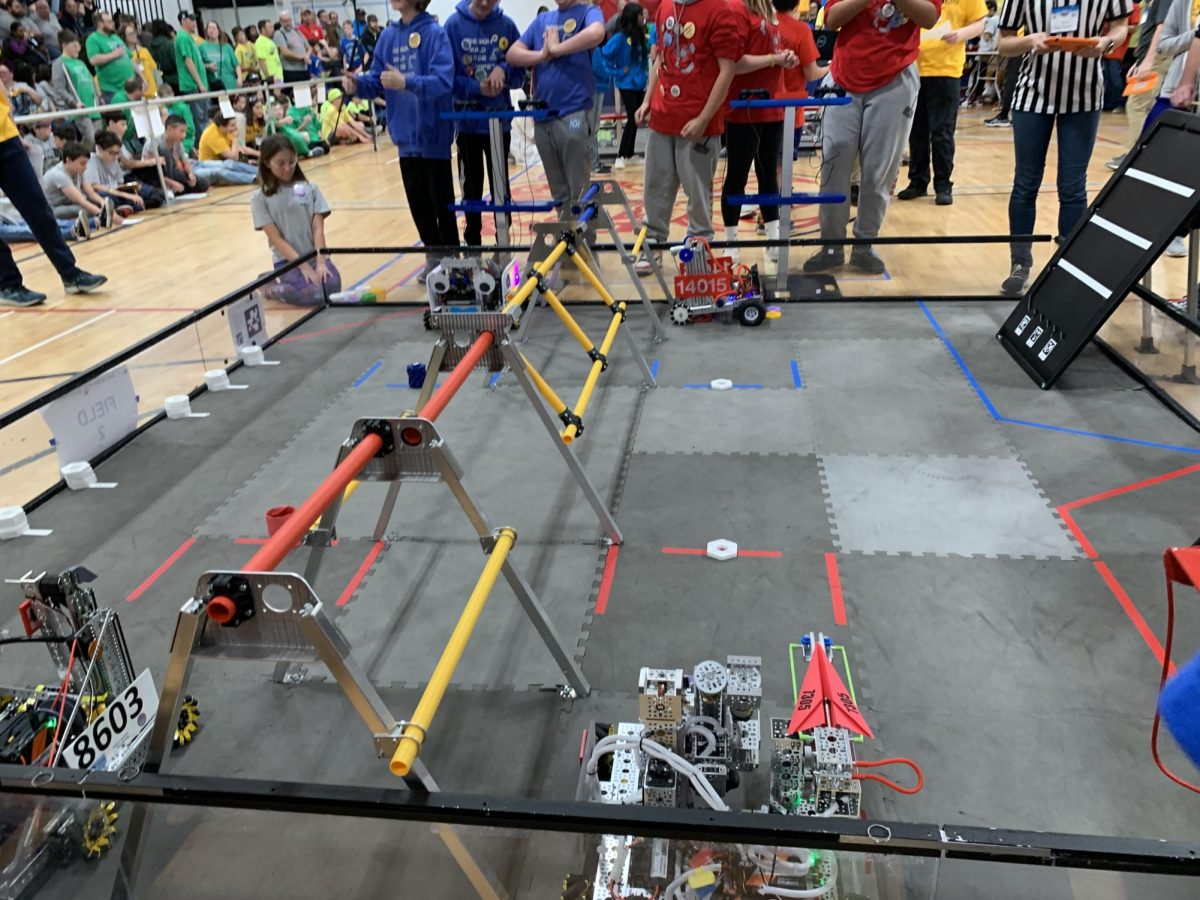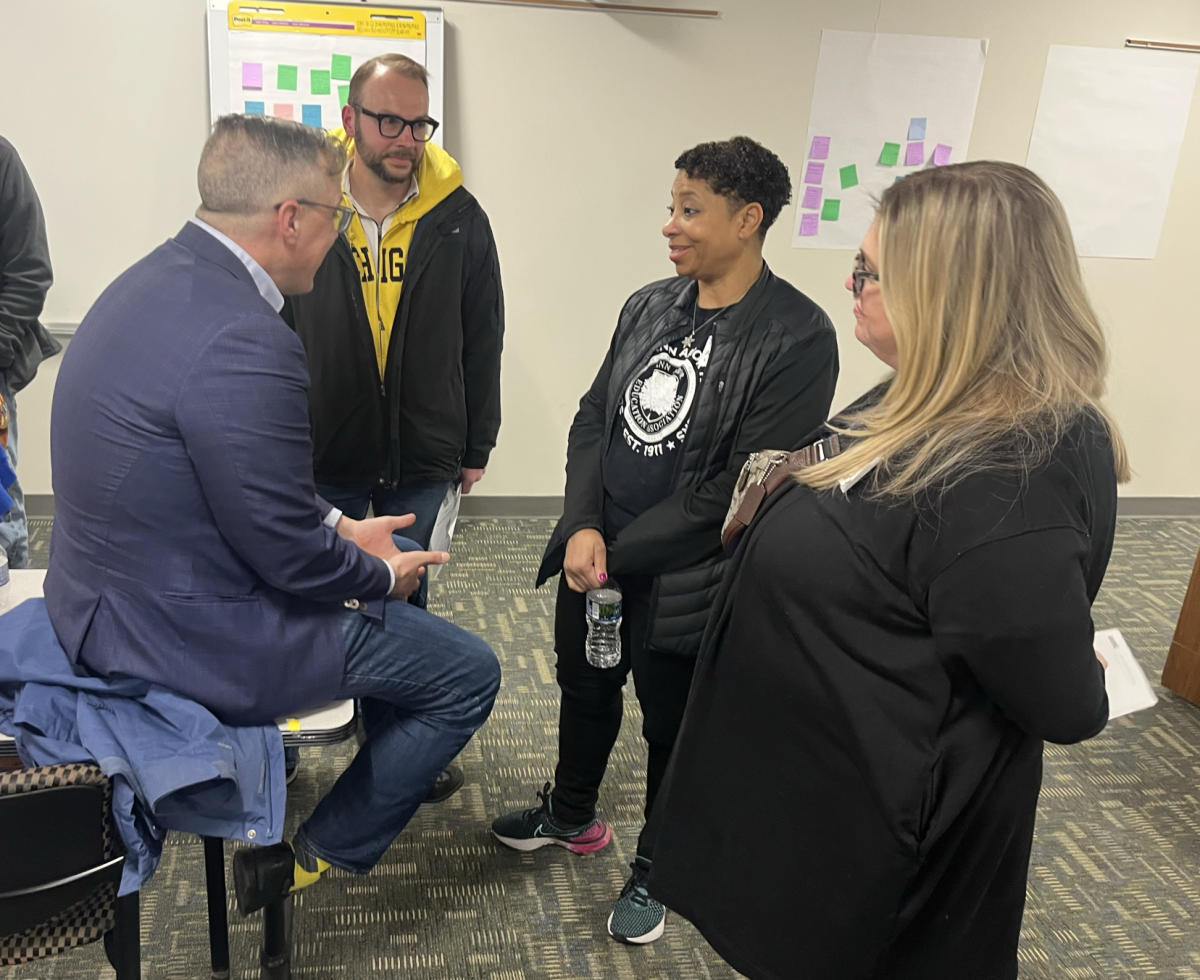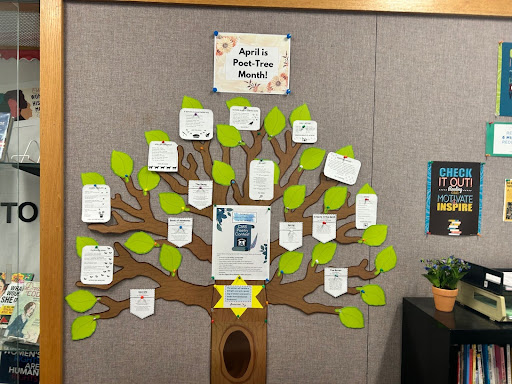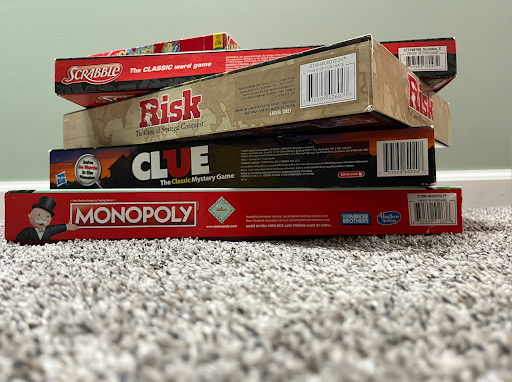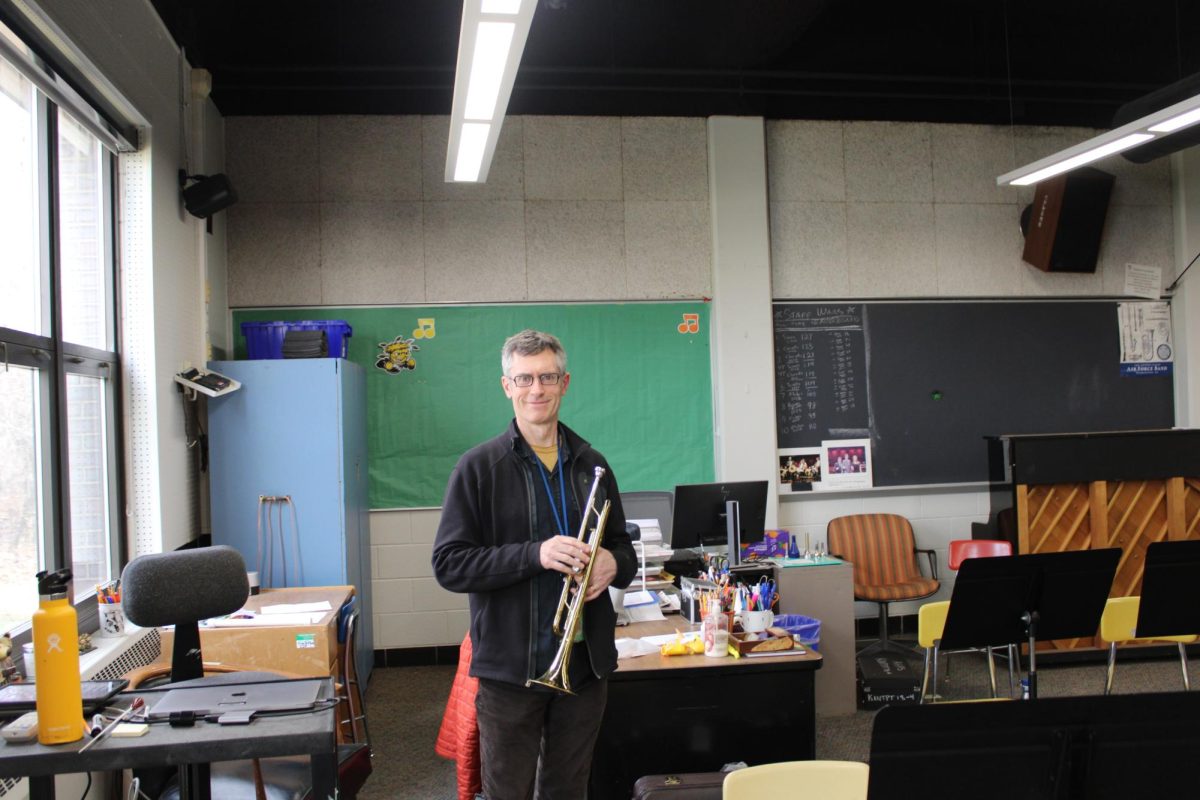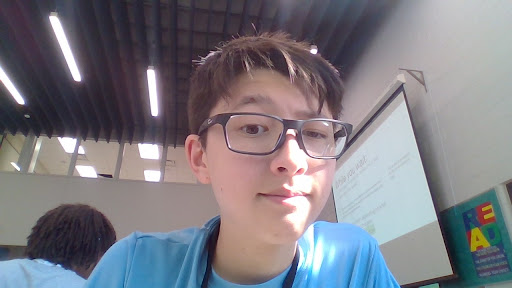The Clague Gearcats are the members of this year’s robotics club at Clague Middle School.
This year’s FTC (First Tech Challenge) Challenge is composed of three parts: The Autonomous Period, The Driver Control Period, and The Endgame. The Autonomous Period requires the robot to move by itself to place hexagonal objects, called “pixels,” onto strips of tape, called “spike marks.” These pixels are also placed on a plastic tray standing at an angle, called the “backboard,” based on where a second white pixel is placed randomly by the officials on a spike mark, earning points for that alliance. An alliance is a group of two teams who compete on the playing field against another alliance. It also requires the robot to park in an area in the back of the field, called the “backstage,” to score extra points.
The Driver Control Period requires two drivers on each team to maneuver the robot in order to pick up and place pixels on the spike marks and backboard in order to earn points for the alliance. The Endgame is a 30-second extension of The Driver Control period where the drivers must shoot off a “drone” (essentially a paper airplane) onto the areas marked just outside the wall of the field. There are three areas to land the drone: the 30-point area, 20-point area, and 10-point area. The area closest to the wall earns the most points for the alliance whose drone lands there. After that, the drivers will hang the robot on the overhead truss using the robot arm to end the game. This will also earn points for the alliance.
Mrs. Mary Manthey, the director of the robotics club, expertly sums up the challenge. “During this year’s competition at Forsythe Middle School,” said Manthey, “Clague’s two teams competed head to head, by designing, building, and programming two robots to compete in an alliance format against other teams.”
The Gearcats are split into two team divisions, the coding teams and the building teams. Both started with difficult beginnings: little funding for robot parts and computers to code on. This consequently resulted in members of the Gearcats to be unfocused because there was little to do during practice. However, after receiving a grant, all necessary materials for building the robot were bought. This robot would eventually come together as a finished product called “7305,” after the team number.
Since the Gearcats were now focused, they could begin to make progress on the build. Starting with the chassis–the basic structure of the robot where the wheels are located–they assembled a strafer chassis from GoBilda, which was a robust structure that used a mecanum drive (a special set of wheels that allow the robot to move sideways and diagonally). The Gearcats also attached an arm to the chassis which had the ability to extend, retract, and rotate along a fixed point.
“Robotics is so cool and interesting. The community is amazing and it is so fun to help build and drive robots,” eighth grade builder Sadie Bohnsack said.
While the building teams were thriving, the coding team was not at its best. Without much experience, they were making little progress during practice. But with a lots of help from Mr. Chih Lin, a professional programmer, the coders started to eventually get the hang of it. They finished their first test code to see if the new arm works, and both the code and the arm functioned perfectly. The robot arm could even lift the weight of the entire chassis!
The building teams added more gadgets to the chassis, including a paper airplane launcher from the drone team, a wrist and claw from the arm team, and even a hanging attachment to the arm. The building team also worked on fitting each piece onto the chassis and wiring the motors and servos (very precise motors that move slower and allow for more control) into the control hub and expansion hub correctly.
Meanwhile, the coding team was working on the actual manual controls to be used during the driver control period of the FTC Event. The controls were soon finished for moving the robot, which includes drive controls, preset arm positions to pick up and place pixels, and the paper airplane launching buttons. The arm controls were particularly tricky, requiring each button code to comply with the programming of the others.
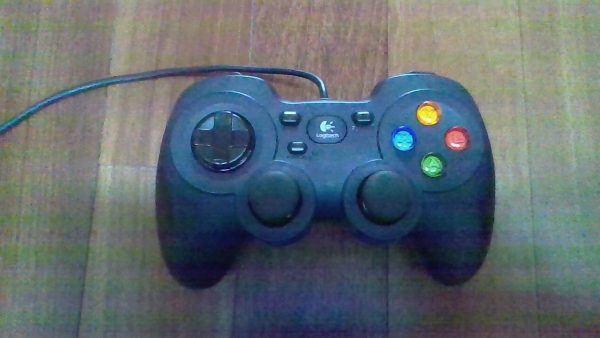
Above is an image of the gamepad on which the manual controls were designed for. Photo credit: Benjamin Lin
After programming manual controls, coding for the autonomous part of the challenge began, which is by far the most tedious programming task. This task requires programming specific movements of the robot based on precise measurements of the playing field, including pixel placements based on the information relayed to the bot from its camera. This part took quite a while, with many bumps along the way, but was ultimately worked out in the end
While the coding team was doing that, the building teams were working to improve the current design of the bot. This includes adding a pixel-straightener to line up the pixel for the claw to pick it up and even a camera mount that moves to detect pixels using a servo.
“We are looking forward to seeing these students continue to advance in the world of robotics,” Manthey said.
As the majority of Gearcats was focusing on perfecting 7305, groups of students from the build teams were assigned to construct an entirely new robot that would also compete in the event. This group would be mentored by a professional engineer, Mr. Andie Lin. It would be a REV Starter Bot that was modified to enhance performance on the field. This group of Gearcats worked day in and day out to ensure that the bot was finished before the day of.
Some of the kids from the group also worked on the coding for the new robot, of course with a bits of help from Mr. Chih. They made drive controls, arm controls, and even manual claw controls rather quickly. They even coded an autonomous program. This was very difficult for them, especially since they had to build and code this on such short notice. But with time, they finally finished.
Mrs. Manthey said, “every year, the Clague Gearcats are becoming more experienced builders and programmers.”
Now, with all of the controls and bots completed, the driving teams began practicing controlling the robots on the field that was set up in the hallway. After a bit of driver practice, the drivers became proficient, and could complete all of the driving tasks with ease.
With all of this said and done, they packed up to head to the FTC Event first thing in the morning.
After the Clague Gearcats were utterly bewildered at how many people were from Forsythe Middle School to compete in the event, they traveled to the designated team “pits,” where they did their final checks on the robots, to make sure that everything was working. Unfortunately for the Forsythe robotics team, one of the motors on their robot broke. The Gearcats who were on the second robot team, luckily had an extra robot just to spare to give to the Forsythe team.
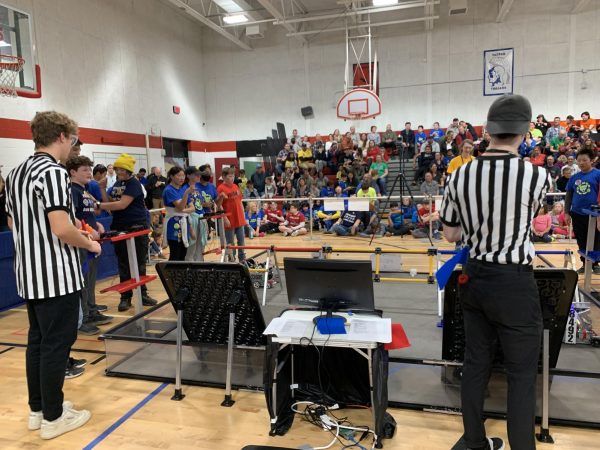
Above is an image showing the amount of people in the stands watching just ONE game, along with countless others watching from the many TVs around the building. Photo credit: Benjamin Lin
The 7305 team began the process of preparing for competition by inspecting the bot to make sure it meets the requirements of the challenge. This involves registering it with the event officials so that they could compete with it. Afterward, they made their way back into the pits and waited for their round to start.
It was finally their turn to compete, and the Gearcats rolled their robot and equipment to the field. After putting the robot and drivers in position, the timer countdowns to zero and they were ready to play. The first game had been a huge success, scoring many more points than the other alliance. This gave them the motivation to continue doing just as exceptional in the next event.
“[The event was] chaotic for sure but also fun and a good learning experience,” eighth grade Builder Meena Pradeep says.
By the end of the qualifying rounds, the Gearcats were feeling hopeful that they would be picked by the top four teams to join them in the semifinals. The first place team picked first. Then the second. And finally the third team chose 7305! The entire team cheered. Even more amazingly, the 4th team chose 23606, another Clague robot! With this news, the Gearcats headed to the field to play.
Unfortunately, the Gearcats were eliminated in the first round; they could not keep up with the smart gameplay of the other alliance. Still, during the whole thing, they wore big smiles on their faces, with their previous achievements in the back of their heads.
At the end of the FTC event, Mrs. Mary Manthey reveals to the team their placing. “Clague came in seventh and eighth place out of 36 other Michigan teams.” Mrs. Mary Manthey said, “what an amazing accomplishment!” The team was ecstatic and ended the night in triumph.

